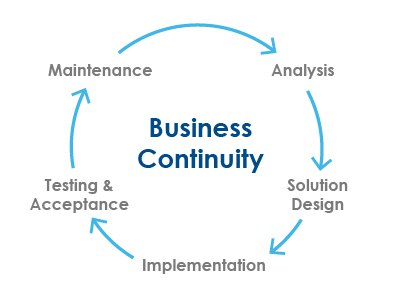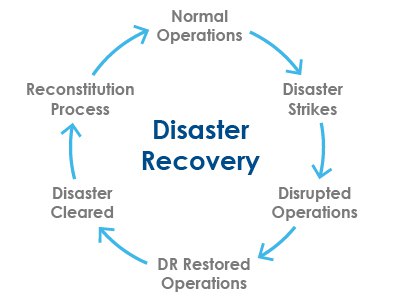Business Continuity vs. Disaster Recovery: What Is The Difference?
Backup and Disaster Recovery | Business Continuity | Disaster Recovery | Managed IT | Network Security & Cybersecurity
What happens when a critical issue arises and affects the momentum of your company’s day-to-day business operations? Whether your business is faced with a major disaster, your business needs to have a plan in place for the business to operate normally again.
When it comes to averting security risks and planning for a disaster, most businesses think that the terms business continuity and disaster recovery are interchangeable when they are not.
Running a business while preparing and planning for a disaster can be hard to do. At LDI Connect, our Managed IT team, we first provide a complimentary IT Security Risk Assessment to assess our client’s current security posture. We then work closely with clients to create a business continuity or disaster recovery plan that aligns with their security needs and goals.
This article will first identify what a disaster is. We will then define business continuity and disaster recovery, along with how they’re different. By the end of this article, you will be able to consider which suits your business.
What Constitutes As A Disaster?
The practice of business continuity and disaster recovery revolves around the before and after events of a disaster. Events are often categorized as a disaster when they are pretty severe and stop a business’s operations from running normally.
These disasters often align with one of the two categories listed below:
Cybersecurity Disaster
Cyber attacks can include malware, distributed denial-of-service (DDoS) attacks, and ransomware attacks.
Essentially any attacks instigated by a malicious perpetrator who wants to gain access to your business’s confidential data, operating systems, and overall IT infrastructure.
Natural Disaster
Natural disasters include fires, floods, earthquakes, tornadoes, hurricanes, industrial accidents, and even epidemics or pandemics, such as COVID-19.
These natural disasters are at times unavoidable and can affect a business’s entire IT infrastructure.
According to The Hacker News, IBM’s studies have found that human error has been a major contributing cause to 95% of all data security breaches. Common human errors such as an employee clicking on a link included in a phishing email or a malvertisement can lead to significant damage to your company’s data and operations.
Whether your company faces a cybersecurity disaster or natural disaster, it’s best to know the difference between business continuity and disaster recovery to decide which is better for your organization.
What Is Business Continuity (BC)
Business continuity involves keeping your business operational while a disaster is in effect.

How? Well, a major part of business continuity is abiding by a business continuity plan (BCP). This plan typically begins with a business impact analysis (BIA) that identifies the plan’s scope and calculates the legal, contractual, and regulatory obligations associated with the disaster.
This analysis acts as the foundation for planning and justification of the costs associated with the business continuity program.
An IT security risk assessment and penetration test often get conducted simultaneously as the BIA; this way, the impacts that may affect your managed service providers (MSPs) can be considered.
Next, your BCP must include a documented plan for maintaining and continuing business operations when a natural or cybersecurity disaster occurs.
Business continuity means implementing risk management tools for your managed IT provider or in-house IT department to follow.
Most importantly, a BCP will include practical alternatives that allow your business to maintain customer services and protect your data even though a disaster is occurring. A few helpful options may consist of data backup or relying on emergency office locations.
What Is Disaster Recovery (DR)?
Rather than finding a way to prepare for the damage a catastrophic event can cause, disaster recovery primarily focuses on getting your business back to normal.

While disaster recovery focuses mainly on restoring your IT environment and data access after a disaster, it also enables your business to return to full functionality after a disaster occurs.
Disaster recovery incorporates a set of tools and procedures that enable the recovery or continuation of your IT infrastructure and systems following a natural, cybersecurity, or human-induced disaster.
Moreover, a disaster recovery plan (DRP) can help your company transition from alternative business processes back to processes your business would follow regularly.
A DRP will contain detailed instructions on how to best respond to unexpected disasters and incorporate strategies to minimize the effects of the disaster on your IT infrastructure and business operations.
This plan aims to help your business regain access to its data and critical IT systems after a disaster has occurred. A DRP ensures that your business can handle and respond effectively to a disaster.
What Is the Difference Between Business Continuity and Disaster Recovery?
While business continuity and disaster recovery focus on helping businesses cope when disaster strikes, there are a few differences.
Here are two main differences to consider.
1. Different Priorities
Business continuity focuses on keeping your business operational during a disaster. In contrast, disaster recovery focuses on restoring your IT infrastructure and data access after a disaster.
Both business continuity and disaster recovery have different priorities, and it’s up to your business to choose which it wants to focus on should a disaster ever occur.
2. Different Plans
Another key difference between business continuity and disaster recovery revolves around when the plan for each takes place.
Business continuity requires your business to keep operations functional during the disaster and right after. Disaster recovery focuses on dealing with the aftermath of the disaster.
While each includes an “after” response, disaster recovery mainly focuses on getting your business back to normal.
For example, let’s say a flood destroys your office’s IT equipment. A business continuity solution may allow employees to work remotely or from another office location that your business has unaffected by the flood.
However, this solution is not sustainable long-term because your company isn’t properly set up for remote work. This solution would not be a sustainable long-term solution.
Your disaster recovery solution would involve getting employees back in their original office location and incorporating ways to replace damaged equipment.
Which Is Right For Your Business?
The truth of the matter is, both business continuity and disaster recovery can help your business. Business continuity acts as a strategy that allows your business operations to carry on with minimal service downtime or outage.
Disaster recovery plans focus on immediately restoring data and critical applications you are operating when a disaster occurs.
Before deciding which one is suitable for your company, identify your priorities. It would also help clarify how long your company can wait to get back to full operation before it starts affecting your finances and reputation.
If your business transactions occur mainly online, your business should prioritize data protection and disaster recovery.
Suppose the disaster mainly affects the safety of your employees and the current work they’re completing. In that case, your business should focus on business continuity.
LDI Connect’s Managed IT team takes a proactive and reactive approach to ensuring your IT environment is equipped to handle disasters. We team can help you craft a detailed BCR, DRP, or both.
Reach out to an LDI Connect representative today to learn more about business continuity and disaster recovery options.